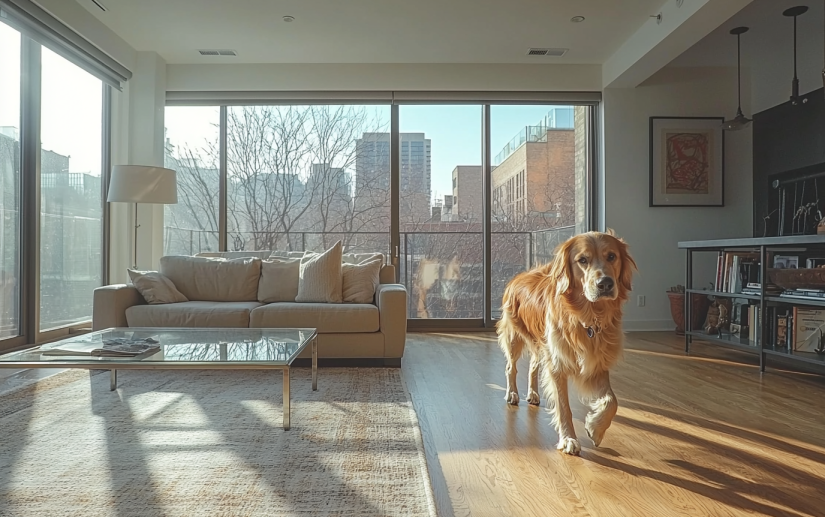What is Dog Pacing?
Dog pacing is a repetitive movement where a dog walks back and forth, often along the same path or in a certain area. It’s a behavior that can be concerning, especially if it becomes frequent or obsessive. Pacing can occur for various reasons, ranging from excitement to stress, and even medical conditions. While occasional pacing might be harmless, excessive pacing often indicates that something isn’t right with your dog. It’s important to pay attention to this behavior, as it can be a sign of anxiety, boredom, physical discomfort, or cognitive decline, especially in older dogs. Understanding the cause of your dog’s pacing is the first step toward helping them feel more at ease.
Causes of Dog Pacing
Pacing in dogs can be triggered by various factors. Below are the primary causes and how they manifest.
1. Anxiety and Stress
Anxiety is one of the most common reasons for dog pacing. Dogs may pace when they feel stressed, scared, or overwhelmed. This could be caused by changes in the household, such as new family members or pets, unfamiliar visitors, or even a move to a new home. Loud noises, like fireworks or thunderstorms, can also trigger pacing in anxious dogs.
Pacing is a physical manifestation of their emotional distress, as dogs are often unable to express anxiety in other ways. This behavior serves as a coping mechanism, helping them release built-up nervous energy.
Separation Anxiety:
Dogs suffering from separation anxiety may pace when left alone. This can be especially problematic if your dog is deeply attached to you and cannot tolerate being away from their primary caregiver. In such cases, pacing may be accompanied by other behaviors like barking, whining, or destructive behavior.
2. Medical Conditions
Pacing can also indicate that something is physically wrong with your dog. Various medical issues can contribute to restlessness and pacing, including:
- Pain: Dogs in pain, especially from conditions like arthritis, hip dysplasia, or injury, may pace as a way of trying to find a comfortable position.
- Illness: Dogs suffering from internal discomfort, gastrointestinal issues, or other underlying health problems may pace to cope with their distress.
- Cognitive Dysfunction Syndrome (CDS): Similar to Alzheimer’s in humans, CDS affects senior dogs and can lead to confusion, disorientation, and pacing. This condition is common in older dogs and may manifest as night pacing or aimless wandering.
3. Boredom and Lack of Stimulation
Dogs are active, intelligent animals that need regular physical and mental stimulation. Without enough exercise or activities to keep them engaged, they can become bored. Boredom often leads to pacing as dogs try to expend pent-up energy. This is especially common in high-energy breeds that require significant daily activity.
Lack of mental stimulation can also contribute to pacing, as dogs need more than just physical exercise to stay satisfied. Puzzle toys, training, and interactive play are essential to prevent pacing related to boredom.
4. Age-Related Pacing in Senior Dogs
As dogs age, their behavior can change, and pacing is a common symptom in older dogs. This could be due to cognitive decline (as mentioned earlier), but it might also be related to discomfort from arthritis, loss of hearing or vision, or general confusion about their surroundings. Elderly dogs may pace at night when they feel disoriented or unsure of their environment.
Signs and Symptoms of Dog Pacing

Recognizing pacing behavior is fairly simple, as it’s characterized by repetitive walking, usually in a specific path or pattern. However, pacing is sometimes accompanied by other signs that indicate a deeper issue:
- Restlessness: Your dog seems unable to settle down, constantly moving from room to room or shifting positions frequently.
- Panting or Whining: These behaviors, coupled with pacing, may indicate anxiety or physical discomfort.
- Licking or Scratching: Compulsive behaviors like licking their paws or scratching furniture may occur alongside pacing.
- Changes in Appetite or Sleep Patterns: A dog that is pacing may also exhibit changes in eating habits, sleeping patterns, or general behavior, suggesting something more serious than boredom.
When to Worry About Dog Pacing
Pacing is not always a sign of trouble. In some cases, it could be a normal response to excitement, hunger, or a need to go outside. However, there are instances when pacing can signal a more significant concern.
Normal Pacing vs. Concerning Pacing
- Normal Pacing: If your dog paces occasionally, perhaps before a meal or when they’re eager for a walk, it’s likely just routine behavior. Some dogs also pace when excited or playing.
- Concerning Pacing: If your dog’s pacing becomes excessive, happening frequently throughout the day or night without any clear trigger, it could be a sign of a deeper issue. Persistent pacing, especially if accompanied by signs of anxiety, distress, or medical symptoms, should not be ignored.
Red Flags That Signal Medical Issues
- Sudden Onset of Pacing: If your dog suddenly begins pacing without any previous history of this behavior, it’s essential to consult a veterinarian. This could indicate pain, illness, or an underlying condition that requires medical attention.
- Night Pacing: Pacing during the night may signal cognitive dysfunction in older dogs or discomfort caused by pain or illness.
- Increased Vocalization: If your dog paces and begins to whine, bark, or howl excessively, it could point to anxiety or physical discomfort.
How to Calm a Pacing Dog

Once you’ve determined that your dog is pacing due to anxiety, boredom, or stress, there are several ways you can help calm them and reduce the pacing behavior.
1. Techniques for Reducing Anxiety
- Create a Safe Space: Designate a quiet area of your home where your dog feels safe and secure. This can help them retreat during stressful situations like thunderstorms or when visitors arrive.
- Use Calming Aids: Products such as calming sprays, pheromone diffusers, or anxiety wraps can help soothe an anxious dog. In some cases, playing calming music or using white noise machines may also help reduce anxiety and prevent pacing.
- Desensitization Training: If your dog’s anxiety stems from specific triggers, like loud noises or separation, gradual desensitization can help them become more accustomed to those triggers over time.
2. Providing Mental and Physical Stimulation
- Exercise: Regular physical activity is essential for preventing boredom-related pacing. Ensure your dog is getting enough walks, playtime, and opportunities to burn off energy.
- Interactive Toys: Engage your dog’s mind with puzzle toys, treat-dispensing balls, or games that challenge their problem-solving skills. Mental stimulation is just as important as physical exercise, especially for intelligent breeds.
- Training Sessions: Incorporate obedience or trick training into your dog’s routine to provide mental stimulation and strengthen the bond between you and your dog.
3. Creating a Calm Environment
Sometimes, environmental factors contribute to a dog’s pacing. Creating a more peaceful home environment can reduce their stress:
- Minimize Noise and Distractions: If loud noises or a chaotic household are causing anxiety, try to limit these stressors. Close windows, use white noise, or move your dog to a quieter area when necessary.
- Establish a Routine: Dogs thrive on routine, and predictability can help reduce anxiety. Feeding, walking, and playtime should happen around the same times each day to help your dog feel more secure.
Medical Solutions for Dog Pacing
If the pacing is caused by a medical condition, addressing the underlying issue will likely resolve the behavior.
1. Veterinary Diagnosis and Treatment
Consulting a veterinarian is crucial for dogs that suddenly develop pacing behavior or show signs of illness or pain. A vet can conduct a thorough examination to rule out health issues such as arthritis, gastrointestinal problems, or cognitive dysfunction. They may recommend specific treatments based on their findings.
2. Medications for Anxiety or Pain
- Anxiety Medications: If pacing is driven by anxiety, your vet may prescribe anti-anxiety medications or natural supplements like CBD oil or L-theanine to help calm your dog.
- Pain Relief: For dogs pacing due to pain, your vet may prescribe anti-inflammatory drugs, painkillers, or other medications to alleviate discomfort.
3. Cognitive Dysfunction in Elderly Dogs
If your senior dog is pacing due to cognitive dysfunction, there are medications and supplements available that can help slow the progression of the disease and improve quality of life. These may include prescription drugs such as selegiline or dietary supplements like omega-3 fatty acids and antioxidants.
Behavioral Solutions to Stop Pacing

In cases where pacing is behavior-driven rather than medical, implementing training and behavior modification can help stop the behavior.
1. Training and Behavior Modification
Behavioral training can help address anxiety and other issues that cause pacing. Working with a professional dog trainer or behaviorist may be necessary if the pacing is severe.
2. Creating a Consistent Routine
As mentioned earlier, dogs thrive on routine. Sticking to a predictable schedule for feeding, exercise, and bedtime can reduce pacing behavior, particularly in anxious or stressed dogs.
3. Dealing with Pacing at Night
If your dog is pacing at night, particularly older dogs, ensuring they have a comfortable sleeping area and access to water may help. If cognitive dysfunction is at play, talk to your vet about medications or supplements that can improve sleep and reduce nighttime pacing.
Conclusion
Dog pacing is a behavior that can be caused by a variety of factors, including anxiety, boredom, medical conditions, or cognitive decline in older dogs. While some pacing is normal, excessive or sudden pacing may signal a deeper issue that requires attention. By understanding the underlying causes of your dog’s pacing and implementing the right solutions—whether behavioral or medical—you can help your dog feel more comfortable and reduce their need to pace. If in doubt, always consult with your veterinarian to rule out serious health concerns and find the best course of action for your dog’s well-being.





